Glimpse of Hoskote lake
Wetland, as the name says the land that is wet.
So every land that is wet is a wetland ? You may ask.
Well! not exactly, the land should have soil on it.
"I see, then can we consider the water that settles over a part of the soil on the side of the road that we see especially after a heavy downpour is a wetland?"
Umm... no, that does not count either because there is no vegetation in or around it.
You see, here is a way you can define a wetland. If the soil is covered with water either permanently or seasonally along with a vegetation and animal life in or around it. And while technically those are the key factors that determine the wetland, if you observe closely towards its vegetation you can determine the type of wetland. One more thing, along with vegetation the source of water also varies with each type of wetland. So clearly, as you may have guessed that Antarctica is the only continent that does not have any wetland.
That births to a thought: can lakes be considered as wetlands?
I am not 100% sure on this although many definitions overlap and incline towards telling you that a lake is a wetland. Personally, however, I do not think so. Because lakes do not have hydric soils beneath them or have vegetation through them. But, the areas surrounding lakes definitely qualify as wetlands because either marsh or swamps are usually seen on their shores.
"What is a Hydric soil?" You may ask.
Hydric, the name that originates from Hydro, indicates an environment which has abundant of water. When the water is ample, there is a lack of oxygen within the soil and this is called as a hydric soil. As a result of this phenomenon, soil supports plants that are adapted to the type of wetland (marsh, swamps etc), fosters many animals and most importantly microbial life.
Allow me to present on few key aspects of wetlands by taking one such lake as an example which has marsh around its shore, Hosakote Lake, located in Hosakote Taluk, Bengaluru Rural district.
This 808 acres lake is a significant water body is ringed with a variety of habitats such as marsh, grassland and shrubs. From the highway, as you turn left (if coming from Bengaluru) right after the toll gate, take the left before the bridge. This road will take you towards the lake. If you choose to visit at dawn, you will be greeted with songs from abundant avian friends such as Red-whiskered bulbuls, Jungle Mynas, sunbirds and various species of warblers. Move your eyes slightly above you can find swallows perched closely to each other on the electric wires. Red-wattled Lapwing screeching distantly as it flies over vegetation. As you continue to walk on the right you will look a large lake witness flocks of different species, some are flying while many are wading silently like Common Coots. Cormorants taking a dip and surprise you by coming out at a distance, sometimes with a fish. You will witness more activities during winter because why not? Around 266 distinct species of birds (according to the data from eBird) had considered this lake and its surroundings as their home either permanently or for a shorter period of time when they migrate from long distances. Two-sixty-six, with that number on her heart, the lake smiles and tells you about the diversity of birds found here.
In this essay I explore different components attached to survival of the lake. This is one of the few places I used to visit often for photographing birds. First time I had visited Hoskote lake was in 2016 and for the next three years my visit was mainly during winters. When I first visited this lake the view of the construction work was distant but concrete had crawled its way towards the lake gradually. Then there was a familiar sight everywhere, plastics and other garbage. I feel there is an urgent need to not only clear the garbage but also find a way to protect the boundaries of the lake.
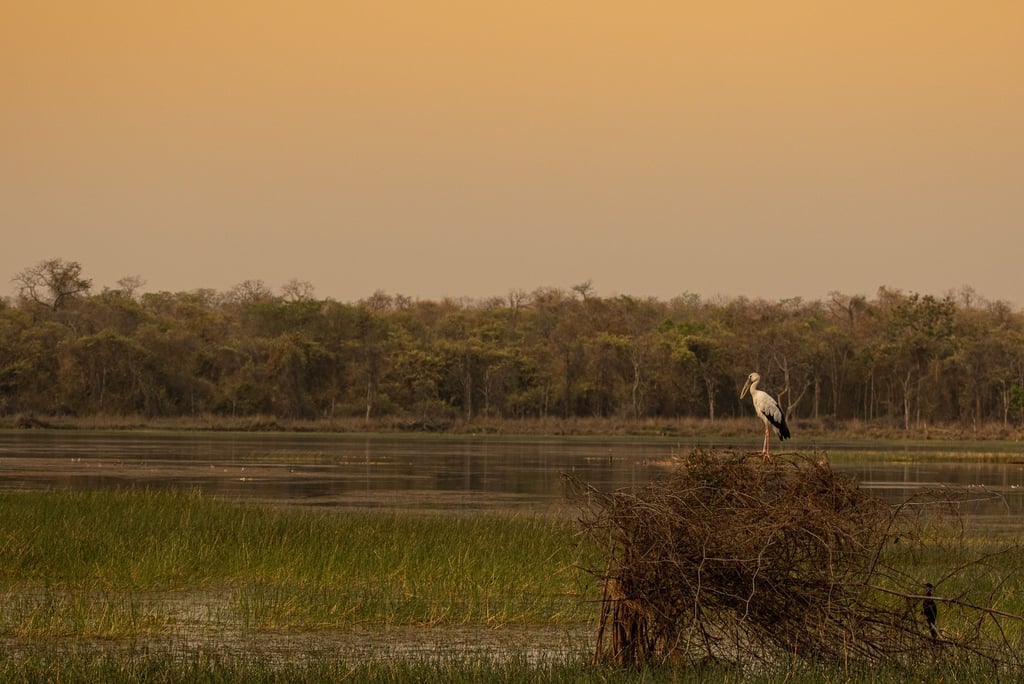

An Openbill Stork (Anastomus oscitans) against the backdrop of a marsh followed by a small forest patch. The marsh is home to many wetland birds, a little cormorant sitting below right of the stork.
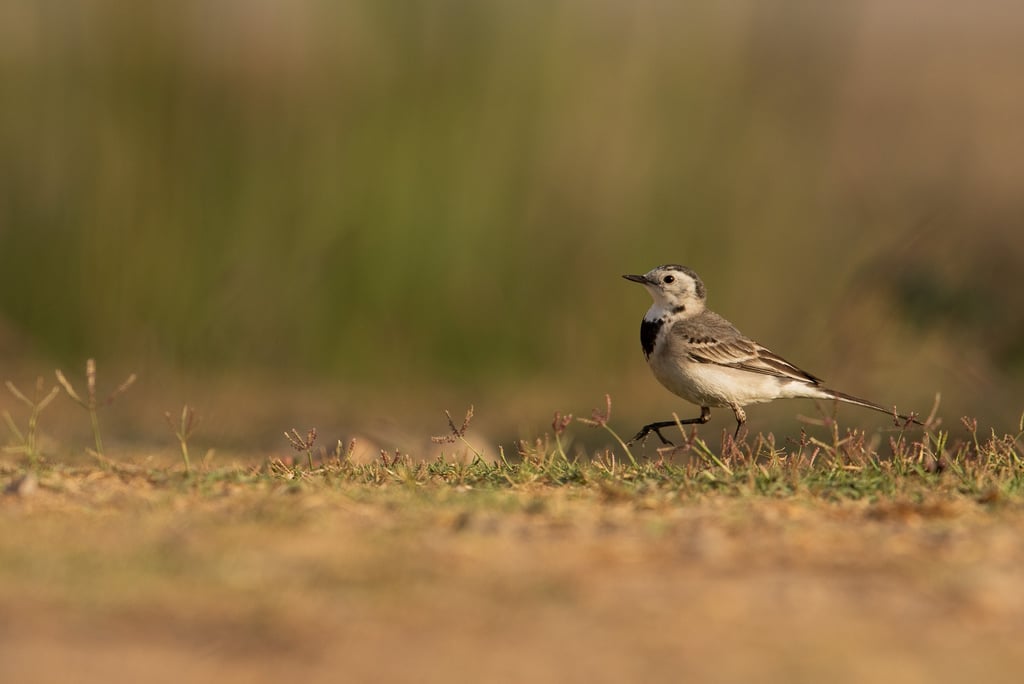

White wagtail (Motacilla alba) which specialists in wetland habitat migrates within India during winter.
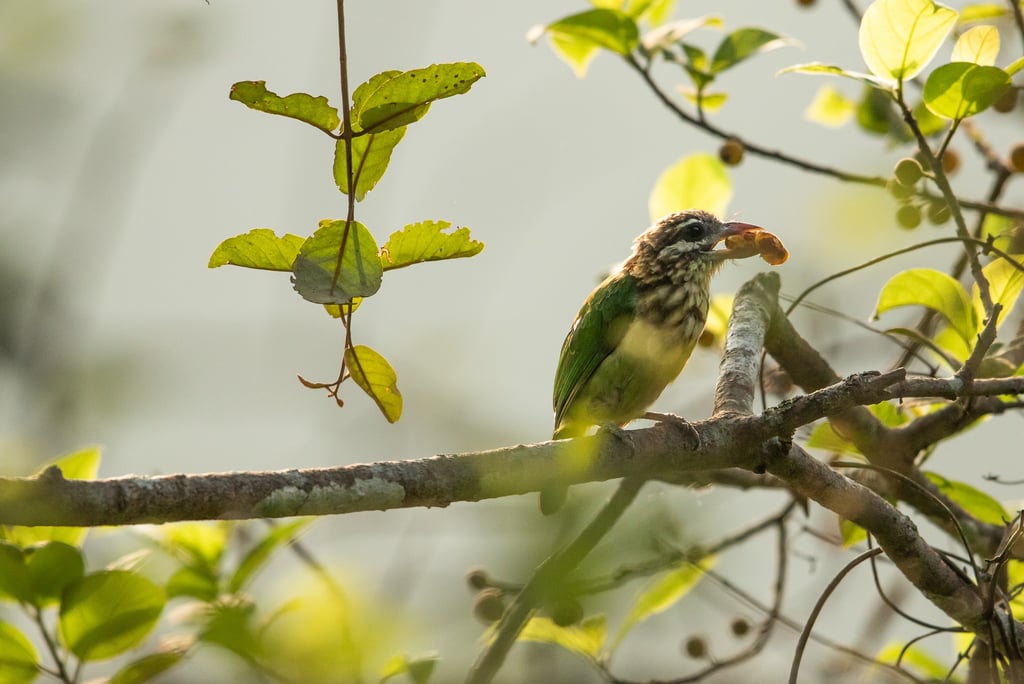

White-cheeked Barbet (Psilopogon viridis), an endemic to the Western Ghats is also seen around the Hosakote lake.
Data source and Acknowledgements:
The dataset (1990 to December, 2024) of birds was downloaded from eBird.
The code for the graphs plotted can be reviewed in the Github page .
GIS images were created from Google Earth Pro.
Soil Health information was captured from Perennial Earth. The satellite images represent the current health of the soil (June, 2025).
A big thanks to Canopy collective for providing the toolkit for conservation. It made connecting all components a bit easier for me.
I do certainly understand the economic benefits by building concretes and I also do understand that expenses poured in when disasters happen and other unfortunate events such as human deaths are pretty high. We have seen various disasters in the past in various parts of the city when the lakes have been replaced by construction works, Bellandur and Varthur lake are prime examples and with latest one in 2025 at Manyata tech park. Wetlands are the primary habitats which gets affected when any city expands.
The lake is already filling with debris waste while the authorities say they will clear the garbage. To me that's the place to start in protecting the lake and its surrounding. Remove the garbage because who does not like to jog or run in a place which is clean. Who does not like to spend quality time at a place which is clean enough to play with their kids. This will also attract more people towards bird watching, so more records of birds and their behaviour. Next step in protecting this lake is any further expansion of concrete should be put to a halt. A more sustainable ways shall be discussed or debated among everyone before raising residential areas instead of putting the weight of a bus stand, a theme park or another gated community on her heart. Karnataka government recognises this lake under the category of Natural/Scenic beauty. It does also provides a gateway to become one of the wetland cities in Ramsar convention. Saving lakes like these not only helps biodiversity but also to humans as well. Think of this, from where do you get the oxygen you breathe?
The narrative on the soil health is based mostly on the colour coded regions that are favourable for birds, bees, microbes and soil in general. But we had also seen certain patches do not have colour coded, they are either covered with water or concrete.
Water is good but with the increase in the concrete around the lake gives an impression to many birds that it is not the right place as of now for breeding and raising their young ones. An increase in cement, steel and paint not only indicates there is a decrease in the vegetation but it also means the probability of an increase in the temperature of air in this area is high. There are potential side effects such as when there is an increase in the air temperature around wetland area, the major consequence is that the water body will absorb more heat and will evaporate more than what it normally does. Which is not good.
With the rise in the heat, people may die due to heat related cardiovascular diseases. There is one more aspect which will cause problem with this phenomena, which is the possibility of Heat Shock Proteins (HSPs) getting affected because of this increase in the temperature. I could not find any study as such which directly links affecting HSPs due to the heat generated in the Urban Heat Island, a phenomenon where an area in the urban experiences warmer than its rural parts. Now, Hoskote lake is in the rural side of Bengaluru hence the affects may not be visible as of now but if the concrete continues to occupy more space especially towards the lake then there is definitely a reason to concern. Starting with an unsettling sight of decrease in the number of birds that migrate and the ones to who stay permanently will face shortage in the food, a severe shortage of a place to take shelter, breed and raise young ones, there will be shortage of fish in the lake which are also a bread winner for the local fishermen. I am assuming there could be other side effects that may arise. Do not forget the Heat shock proteins which play a critical role in promoting tumor progression.
But why do birds migrate ?
They travel from different parts of the world and some within the country, especially during winter and few in summer and monsoon in search of better conditions that will suite them for breeding, feeding and raising their young ones.
Because every bird, whether they migrate from elsewhere or reside here for longer duration, needs a place for shelter, good enough for birds who migrate in large flocks. Others are extremely satisfied with significantly small space. Some like to have good number of trees around them, some primarily prefer the ground to forage and have fun.
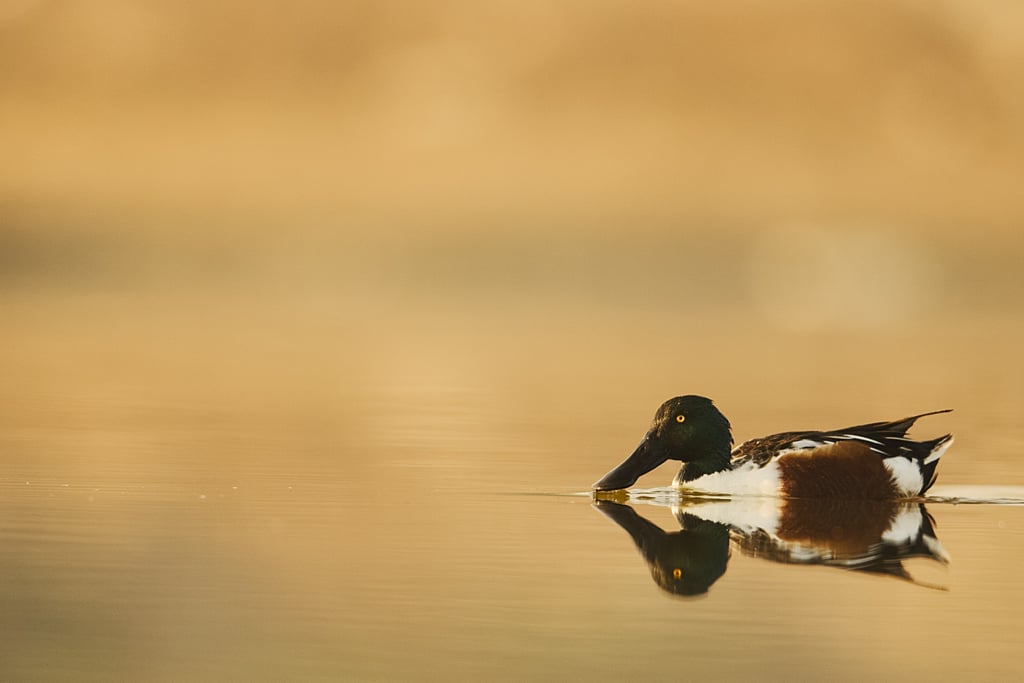

Northern Shoveler (Spatula clypeata), one of the migratory birds that often visits in the lake during winters.
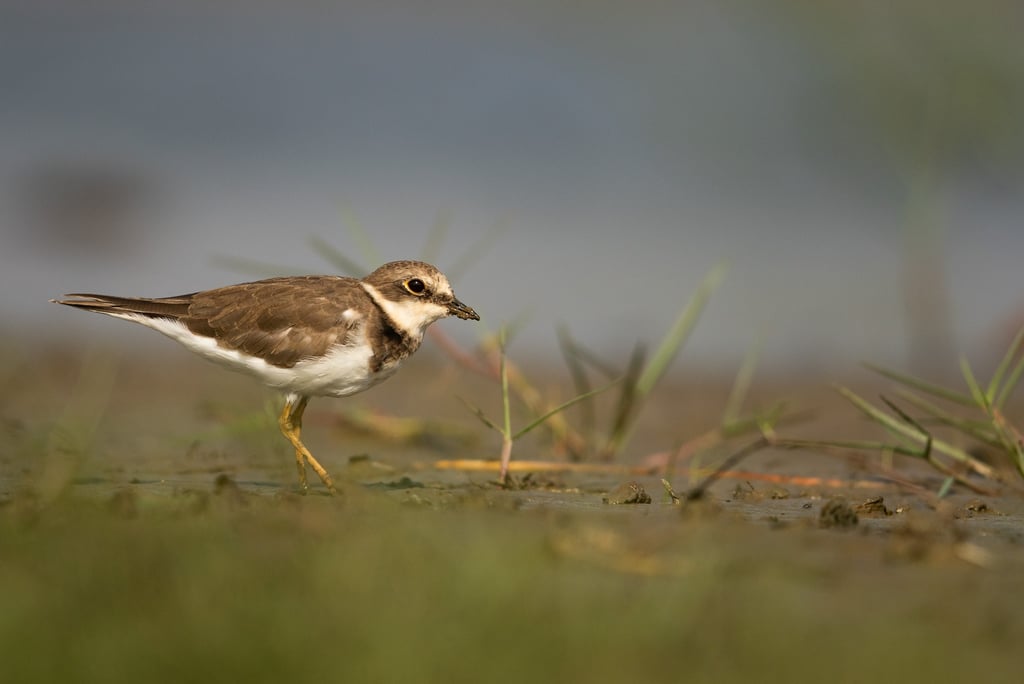

Another visitor, Little Ringed Plover (Charadrius dubius), which migrates within India and few come from outside to winter in the sub continent.
Image taken from Google Earth Pro represents the scenario of Hoskote lake and its surroundings in 1985.
Image taken from Google Earth Pro represents the scenario of Hoskote lake and its surroundings in 2014.
Image taken from Google Earth Pro represents the scenario of Hoskote lake and its surroundings in 2019.
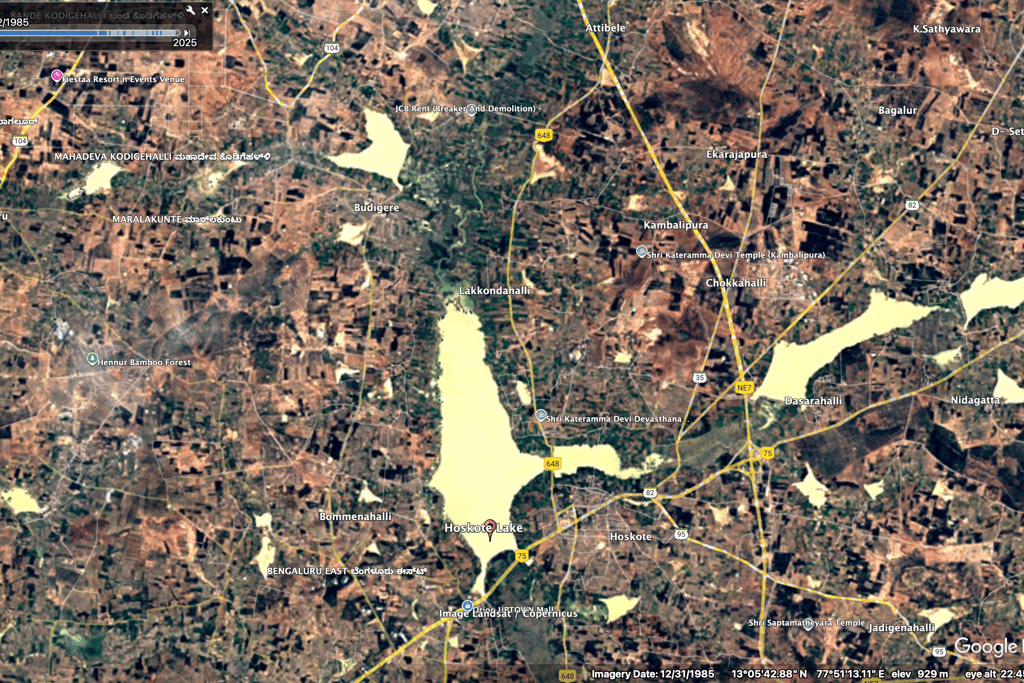

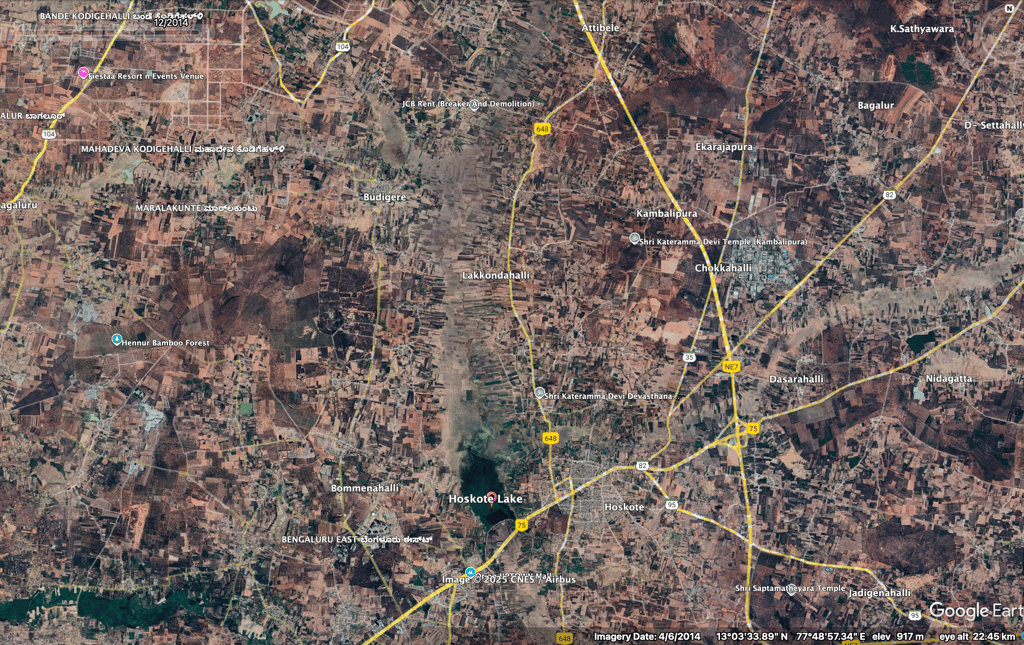

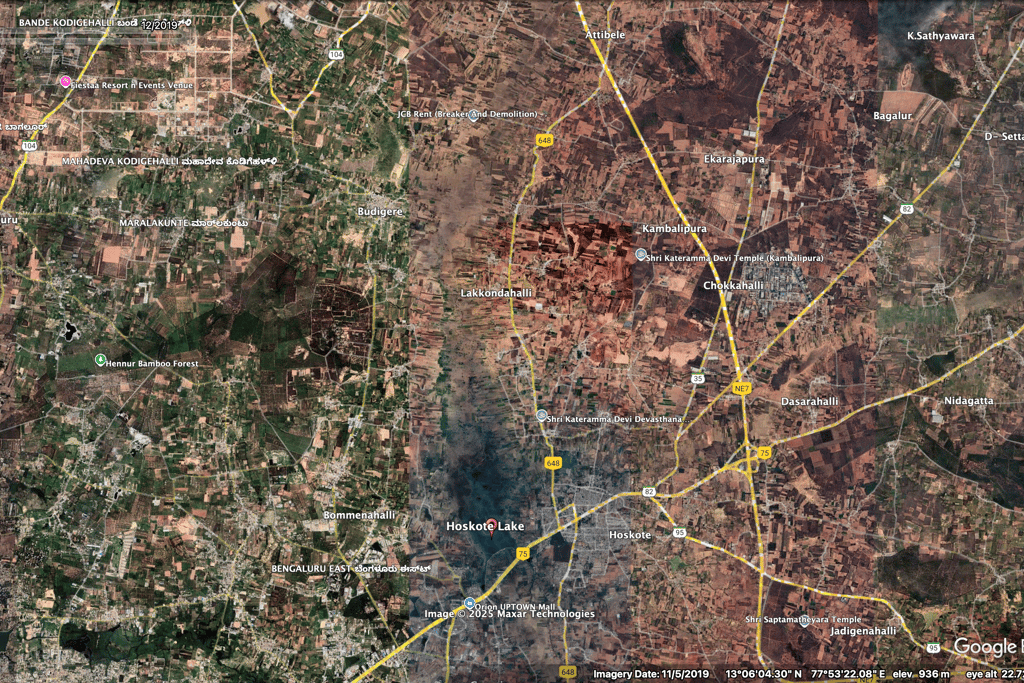

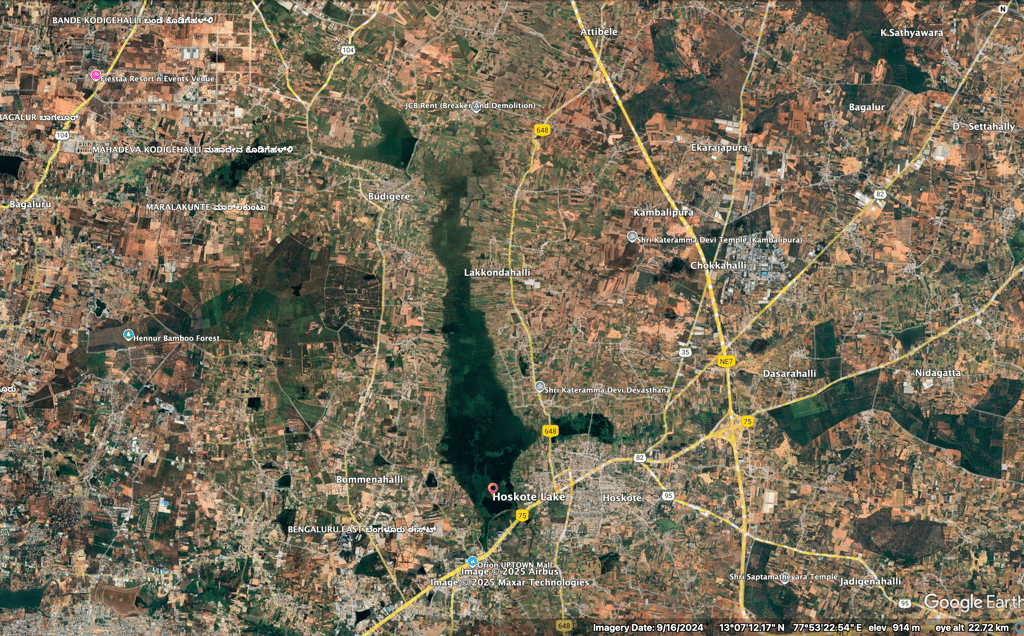

Image taken from Google Earth Pro represents the scenario of Hoskote lake and its surroundings in 2024.
Albeit I could not get images of exact dates of the year, but it does not take away the fact that much of the vegetation has been lost in the four decades. It is visible. But it also made me think that there is still room for birds to thrive here and hence in search of that hope I had turned to sources that gives me information I am looking for, health of the soil.
Allow me to show to you a few images (they are a bit colourful though) of the lake and its surroundings which convey different aspects that measure the soil health. I will briefly explain what these represent followed by my understanding on how everything is interconnected. Every image tells story about the lake and its surrounding habitat.
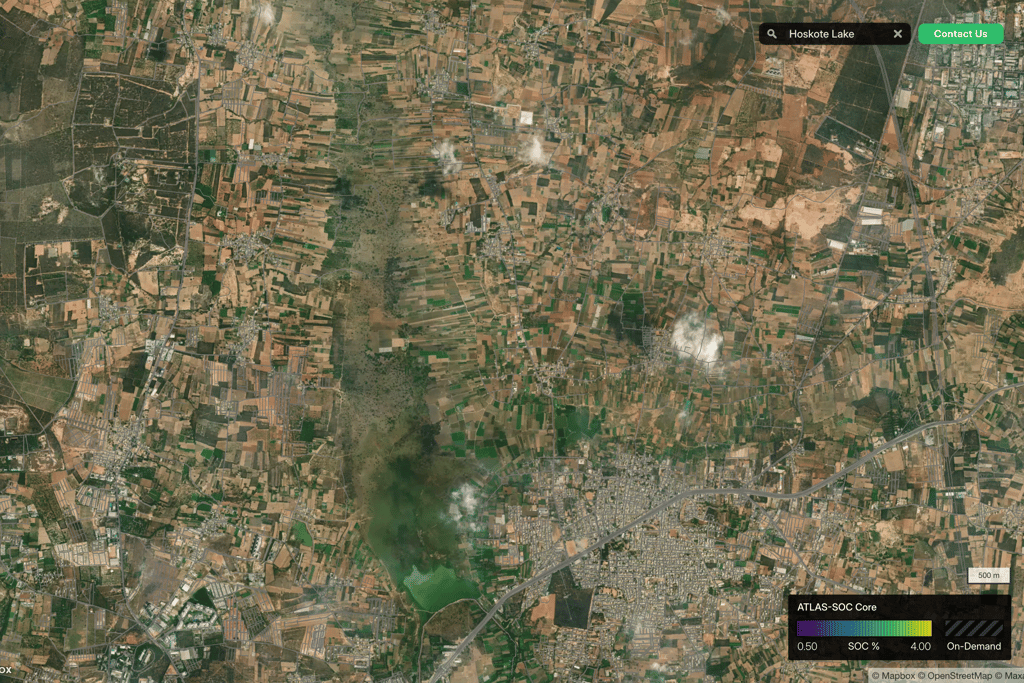

Atlas SOC (Soil Organic Carbon) is the amount of carbon stored in the soil for a given area.
Starting with the first image, Atlas SOC (Soil Organic Carbon). This represents the amount of carbon stored in the soil at a given area. The measurement as displayed in the scale is in SOC %. In the image the green colour that you see around the core part of the lake is the area which stores maximum amount of soil carbon, approximately around 2-2.5% as per the scale.
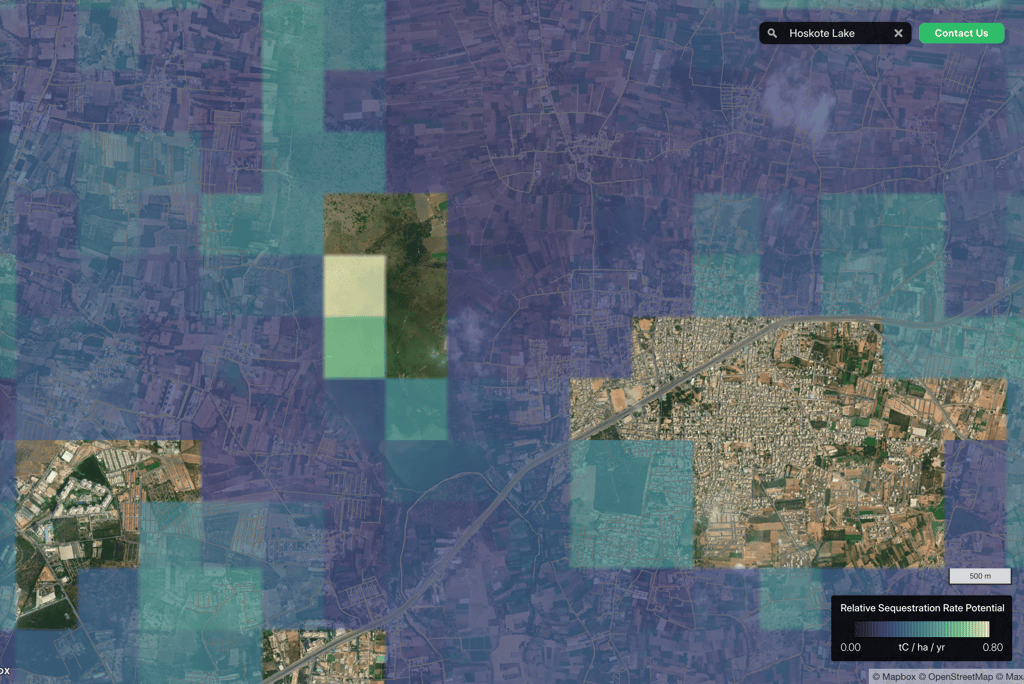

Relative Sequestration Rate Potential. The potential rate at which a soil system can absorb and store additional carbon
While Atlas SOC tells us the amount of carbon stored in a specific place, the speed at which this carbon is absorbed and stored over years is determined by Relative Sequestration Rate Potential . It is measured in tonnes of Carbon per hectare per year. By looking at the image we can see colours coded in gradients of green and purple. There are patches where there is no colour on the right and left, I assume based on what I am seeing is that there is only concrete and no soil that absorbs carbon. And the one in the center is perhaps covered with water.
Back to focussing on the green colours in the image, especially towards the north of the lake where the colour turns more lighter has the potential of storing carbon relatively faster than other regions. As per the scale it is measured up to 0.8 tonnes of Carbon per hectare per year. Although this region might not be in hectares but it gives us information that its storage rate is higher than its surroundings.
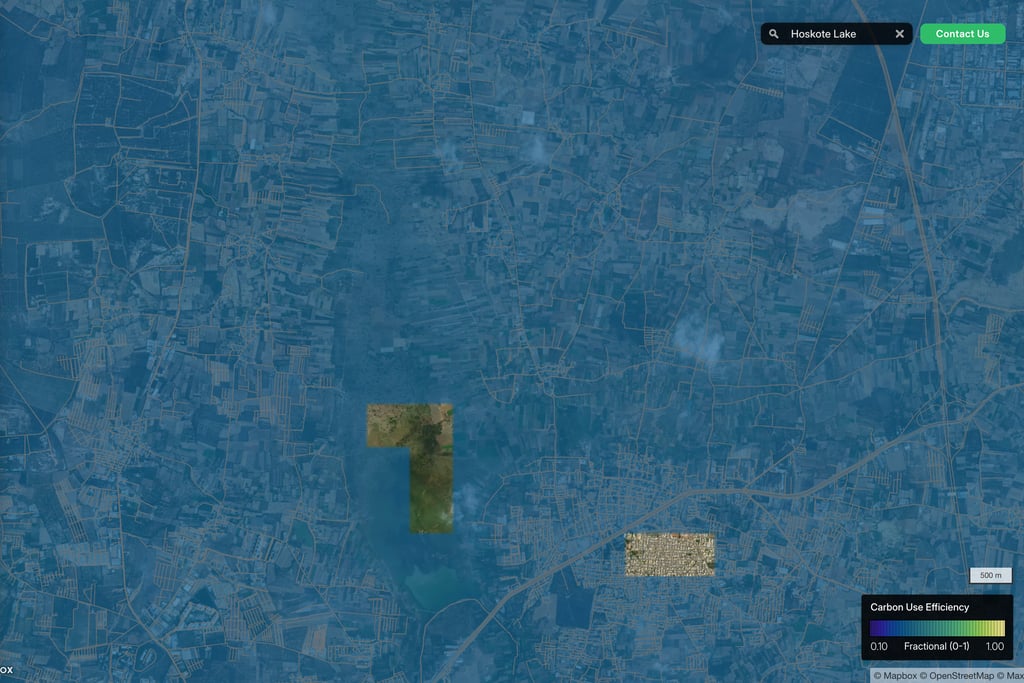

Carbon Efficiency Use. Indicates how efficiently microbes inside the soil convert the carbon they consume into their own biomass versus releasing it as CO₂
Remaining images tell the story more about the role of the protagonists, microorganisms. For instance, Carbon Use Efficiency (above image) tells how efficiently microbes transform the soil carbon into organic biomass. You see bluish-green colours right on the north of the lake (same patch as we had focussed in previous images) which falls from middle to few bars on the right of the scale.
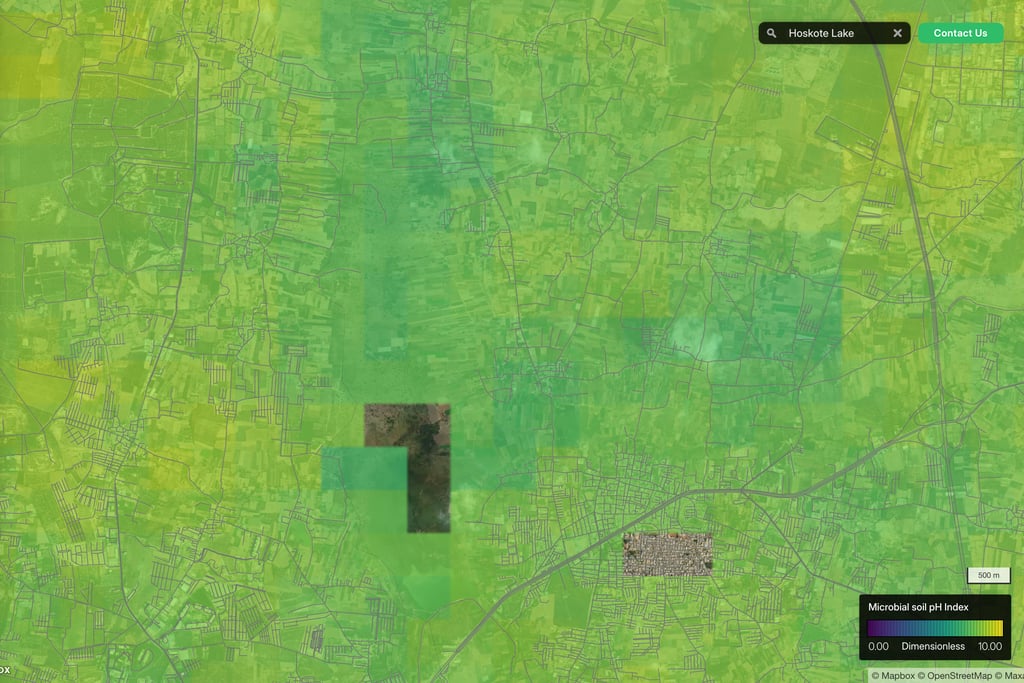

Microbial Soil pH Index. Indicates acidic/alkaline nature of the soil as experienced by microbes.
For the microbes to function effectively which is to take the carbon in the soil, they would need conditions favourable to them and one of them is the pH value. This is given by Microbial soil pH Index. The north of the lake as more lighter green shades, which as per the scale is more favourable for microbes.
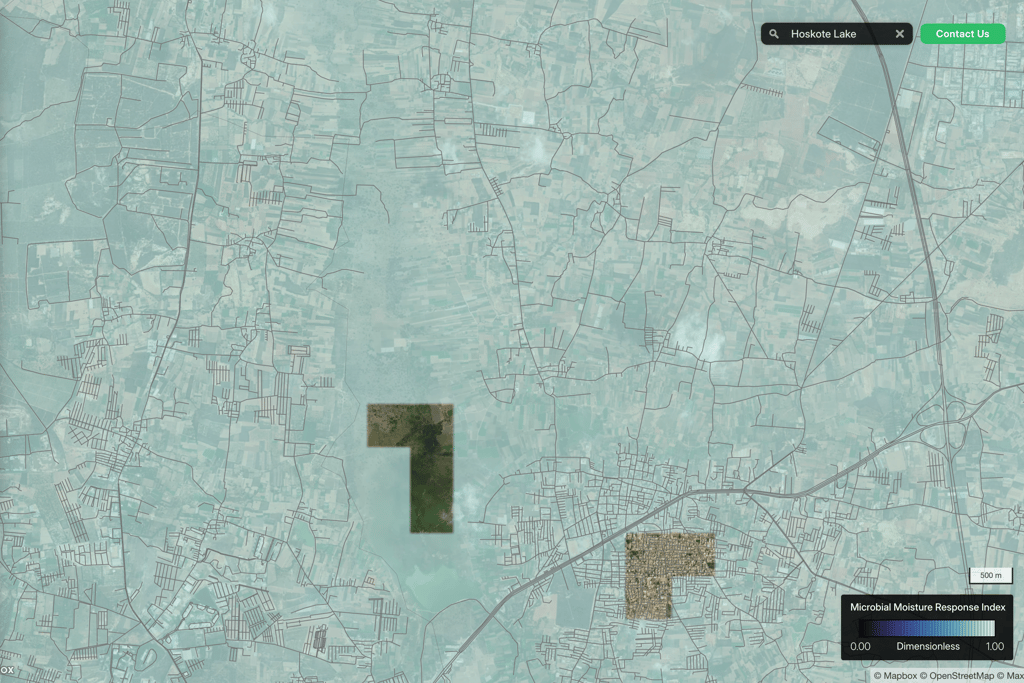

Microbial Moisture Response Index. Indicates how microbial activity and soil carbon sequestration are affected by soil moisture conditions
Perhaps the most important image of all, Microbial Moisture Response Index indicates how well microbes are responding to the given moisture conditions in the region. In this case not only on the north of the lake but the pale blue colour is spread uniformly to further north.
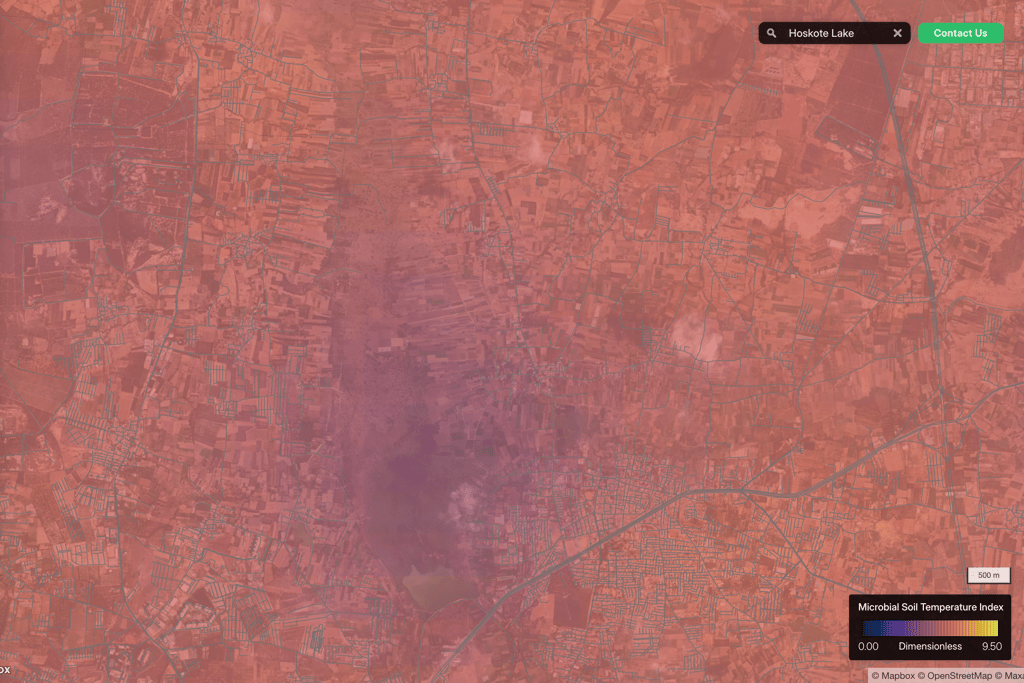

Microbial Soil Temperature Index. Indicates how the temperature of the soil affects microbes.
The only index among others whose values that are favourable to microbes fall on the left side of the scale. The Microbial Soil Temperature Index tells how temperature affects microbial activity. In this case the image has purple shades on the north of the lake and extends further north which according to the scale is relatively lower temperature (compared to the right) and is suitable for microbes to their job.
What we had now observed that the health of the soil looks ok and when there is still enough vegetation around the lake it is normal to witness insects such as caterpillar feeding on the leaves, ants and other insects on the ground. And to feed on these insects various insectivorous such as lizards, spiders and birds. Some of the families of birds which are insectivorous found in and around lake are Chloropseidae (leaf birds), Coraciidae (Rollers), Alaudidae (larks), Acrocephalidae (reed warblers, marsh- and tree-warblers, or acrocephalid warblers) etcetera. But on looking closely on the collected data, most insectivorous are on the decline starting with the state bird of Karnataka, Indian Roller which had decreased 53% since 2019. Warblers collectively reduced 15% , chiefly Clamorous Reed Warbler whose count went down 49%. And larks have reduced by 32%.
The story is no different for birds that prefer fish as their primary diet such as Pelicans, as I witnessed were 29% less, Podicipedidae (Grebes) and Anatidae (ducks, geese etc) have reduced by 51% and 31% respectively. Then there are raptors mainly Falcons which were reduced by 55%. How can we forget guests that visit the lake every winter. Alarming numbers were from the Anatidae family (ducks, geese etc) , where species like Garganey, Northern Pintail, Northern Shoveler have reduced more than 50%.
While the data was consistent for most species since 2017, it is from 2019 there was a steep decline in the count of many species mainly insectivorous.
The scene is certainly not gloomy. There are diverse family of birds which show an increase in their trend or as stable at least such as most people favourite Indian Grey Hornbill, Owls, Bulbuls, Darters, lapwings, pigeons etc. Among these few of them are represented in the below graph
There is no straightforward way to accurately point to conclusion on why there is an increase or decrease in population of these species. There are births and deaths of birds. Some may not have migrated to this part of the geographical area is just one of the various reasons. Certain aspects are understandable such the one of the reasons for the dip from 2020-22 for many species is due to records of these birds might not have taken due covid-19 pandemic. Any other reason for the dip in numbers of certain species that I can imagine may not come close to the truth such as those birds could be more shy than others and prefer not to be disturbed. As a result, rather than foraging in the open they might have move to a secluded place and we could not make a record of theirs. Or perhaps there isn't much place left for them over here to eat or breed and could have been migrated else where. If that is the case, then it would be interesting to see where else they had decided to make their home.
Different kinds of birds prefer building nests at different places. Family of birds such as Podicipedidae (Grebes) prefer nesting on the vegetation, the nest of the Chloropseidae (leaf birds) are at the crown of the tree, Pelecanidae (Pelicans) usually nest in colonies and twigs are placed on a low tree. They build alongside of other waterbirds like Painted Storks, ground birds such as Turnicidae (buttonquail) place their nests on the ground. for feeding, breeding and raising young ones.
When it is about food, they mainly feed on fish, insects, other invertebrates, fruits, grains, seeds and in case of raptors they feed on small birds, small mammals, rodents etc.
Many of these birds are omnivorous so they not only depend on plants and trees for fruits, seeds and nectar from flowers but also on insects as well. While raptors find rodents and other small animals fascinating to them, but for most birds its those small invertebrates such as caterpillars, ants, flies etc are flavourful. And some of these invertebrates, for instance, aphids, caterpillars, beetles, whiteflies, thrips, and weevils also depend on plants. Well for the same reason as many species, food and reproduction.
A caterpillar is attracted to leaves, flowers, fruits so on... and shelter, there is no better place for them than plants. Likewise, Beetles lay eggs inside the tissue of the plants and the young ones can access the food directly.
Just like insects depend on the plants for food, birds also depend on both insects and plants for food. Raptors, within birds, also feed on birds, small invertebrates or animals. The left over dead birds on the ground served as a food for the micro organisms within the soil who then break down the nutrients within these dead birds and send back to the soil which is useful to the plants. The cycle continuous. This is a classic Food Web. It is often the ones which are visible to the human eye are highlighted or more talked about but we ought to discuss about the ones which are invisible to the human eye. Enter the world of microorganisms. To me they are the protagonists in this story. Microbes are supremely responsible in the way ecosystems flourish.
I will be glad to explain the relations with the flow diagram shown below followed by a brief narrative:
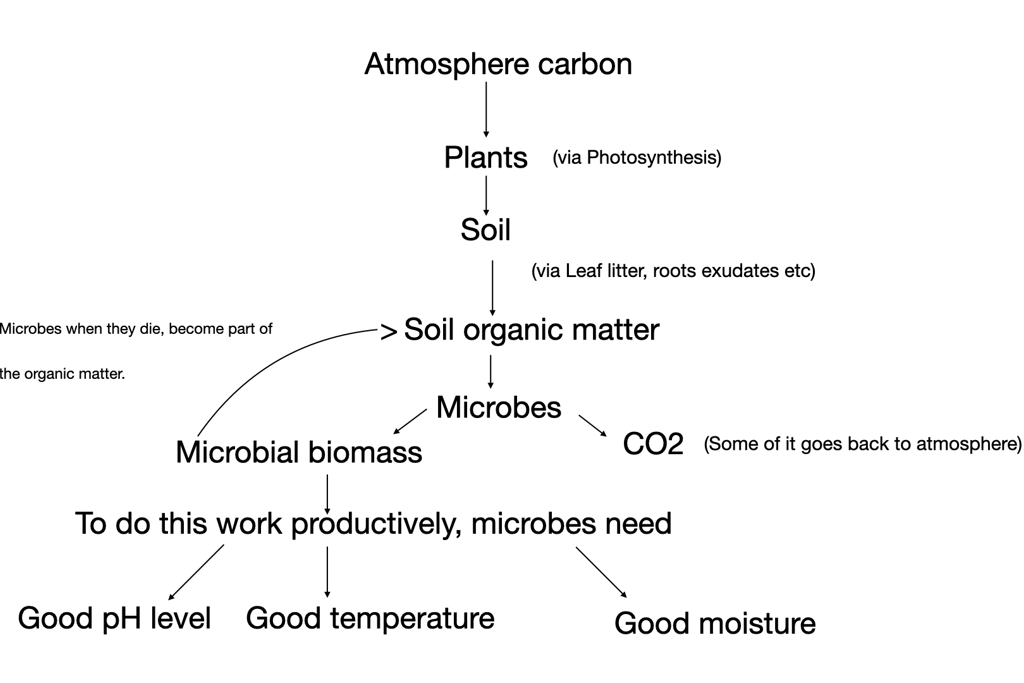

You see, it all starts with Photosynthesis. Plants capture carbon (along with sunlight) from the atmosphere for the Photosynthesis. Along with the fallen leaves, dead parts of plants such as bark, twigs along with certain compounds of its such as sugars, amino acids, enzymes etc (known as root exudates) release into its surrounding soil, carries carbon with them. These are a bliss to microbes such as Bacteria or Fungi. They break down this organic matter, some of the carbon goes back to atmosphere as CO2 and some proportion is transformed into microbial biomass. So think microbes as gatekeepers which decide how much to transform into biomass and back to atmosphere.
How effectively microbes do this job is measured by Carbon Use Efficiency. How effectively this transformation happens is determined by various factors starting with, having appropriate levels of pH level in the soil. For them the soil should neither be to acidic nor too alkaline. Bacteria prefers from neutral to alkaline while fungi may thrive in acidic soils. Next factor that is important to microbes is the temperature of the soil, it should be neither too cold nor too hot. Microbes are active at a very moderate temperatures.
The most important of all factors for microbes to thrive is the moisture content in the soil. This has to be higher. Moisture in the soil plays a key role as it directly affects photosynthesis, soil respiration, microbial activity, and soil organic matter dynamics. If there isn't adequate moisture in the soil then it effects photosynthesis which in turn affects microbes since the input for them, root exudates and litter, gets effected. As a result, microbes function less efficient in decomposing these materials into organic biomass which means it alters the soil structure and availability of nutrients for the plants and this hinders the growth of plants. So its a cycle. Excessive moisture can create anaerobic conditions (lack of oxygen) in the soil which results in increased amount of Methane releasing into the atmosphere by microbes. Hence maintaining optimum levels is important the storage of carbon.
Soil moisture is a key regulator in balancing Carbon Sequestration and Co2 emissions. Good moisture content also influences microbial activity and controls emissions of Methane (CH4) and Nitrous oxide (N2O)
When all these factors such as appropriate levels of pH, moderate temperature and appropriate moisture content align, microbes function well in transforming organic matter into microbial biomass. And finally when microbes die, their remains becomes part of this place where carbon is stored (also known as carbon pool). When microbes function well they provide necessary ingredients (such as Phosphorous) to the plants. Think about this, if birds are migrating from different continents to breed here, what do they eat and where do they get food from? The flowers, fruits, insects are main sources of food for them. When living beings like these live here, their fecal matter and decaying matter of dead birds/bees also become a product of Soil Organic Matter. These living beings depend on the plants and trees that thrive near the lake. On the soil that is kept healthy by these microbes. And because the soil and vegetation are healthy they in turn provide energy to these microorganisms. No matter how you see there is a positive feedback loop everywhere.
Visiting the lake after a gap of three years, the signs of positive loop was diminishing. High rise buildings were more noticeable than before. Surely, it makes anyone wonder what was the scene 3 years, 5 years, 10 years or even 4 decades earlier in an around the lake. It was obviously very different in 1985. As it is clear from the below image, there are many water bodies visible in all directions.
But then these small water bodies became victim one after another. They took the heavy weight of bricks and steel on them year after year. There is no description required, each image tells the story.
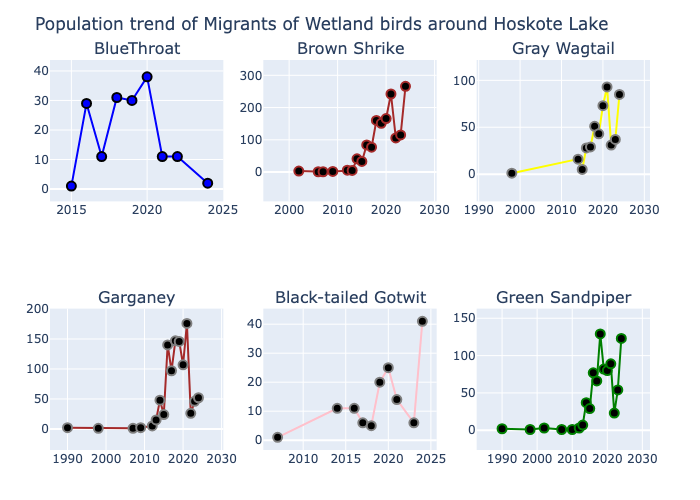

Above graph describes trend of some of the migratory birds found at the lake from various periods. On the x-axis, you can see the years and on the y-axis, the number represents the count of the birds during this period.
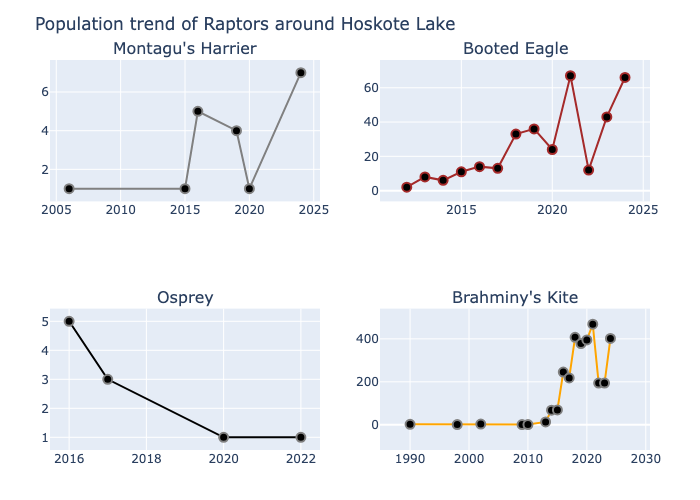

Above graph describes trend of raptors found in the lake from various periods. On the x-axis, you can see the years and on the y-axis, the number represents the count of the birds during this period.
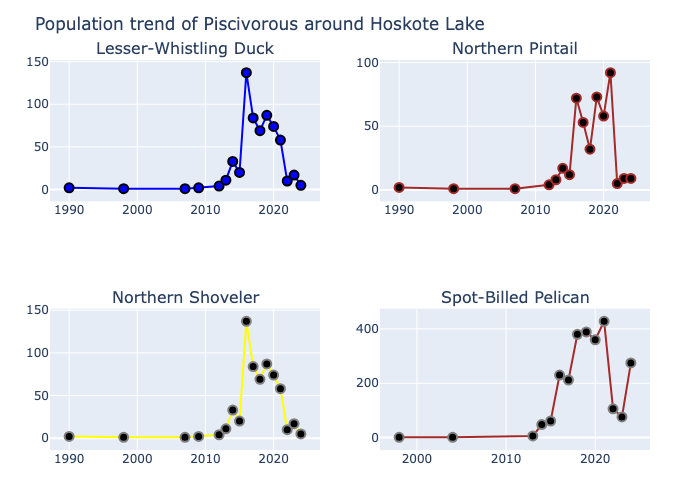

Above graph describes trend of piscivorous found in the lake from various periods. On the x-axis, you can see the years and on the y-axis, the number represents the count of the birds during this period.
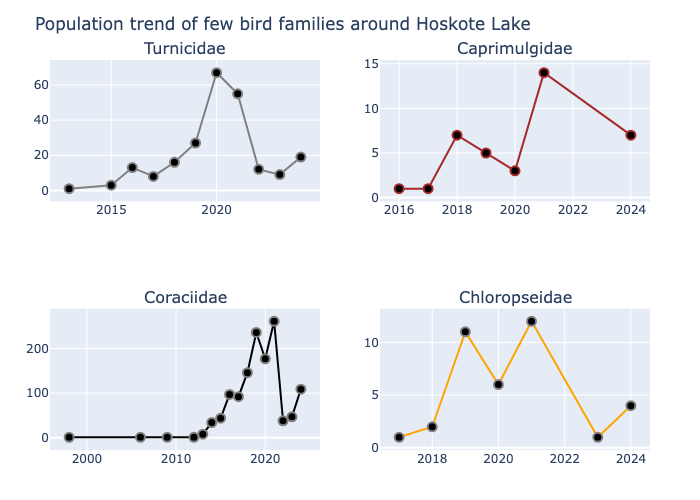

Above graph describes trend of Insectivorous found in the lake from various periods. The families in the top row are Button quails, Nightjars and in the second families are Rollers and Leaf birds. On the x-axis, you can see the years and on the y-axis, the number represents the count of the birds during this period.
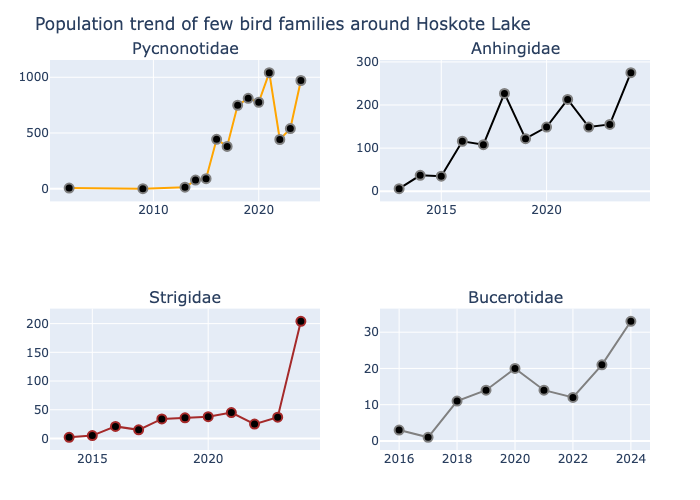

Above graph describes trend of four families of birds found in the lake from various periods. The families in the top row are Bulbuls and Darters. In the second row families represent are Owls and Hornbills. On the x-axis, you can see the years and on the y-axis, the number represents the count of the birds during this period.
Many birds such as Purple Heron (Ardea purpurea), Egrets (Little [Egretta garzetta], Intermediate [Ardea intermedia], Great [Ardea alba] and Cattle [Bubulcus ibis]), Cormorants (Indian [Phalacrocorax fuscicollis], Little [Microcarbo niger], Great [Phalacrocorax carbo]), Black-headed Ibis (Threskiornis melanocephalus) are some of them which are found throughout the year in this wetland.
And there are gorgeous guests that visit in and around this wetland, some of them include - Northern Shoveler (Spatula clypeata), Northern Pintail (Anas acuta), Black-tailed gotwit (Limosa limosa), Bluethroat(Luscinia svecica), Western Marsh Harrier (Circus aeruginosus) etc. These visit during winter almost every year.
